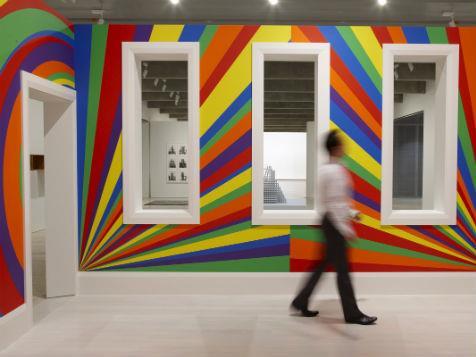Sol LeWitt, Wall drawing #1091: Arcs, circles and bands, 2003
A premiere exhibition by the late American conceptual art pioneer Sol LeWitt at the Art Gallery of New South Wales (AGNSW) brings his work into conversation with contemporary Australian artists for the first time.
Opening at AGNSW on 20 February, Sol LeWitt: Your mind is exactly at that line spans the 40 years of LeWitt’s career and showcases four new wall drawings, three of which have been created exclusively for the Australian exhibition.
Widely recognised for his use of lines, squares and cubes, LeWitt’s distinct visual language was explored in greater detail with his landmark 1967 essay entitled Paragraphs on conceptual art, where he wrote ‘in conceptual art the idea or concept is the most important aspect of the work’.
LeWitt’s systematic working methods materialised in unforeseen and surprising ways, often in the case of the site-specific wall drawings, which form the centrepiece of the exhibition.
‘The exhibition highlights LeWitt‘s contact with Australians such as John Kaldor and Harry Seidler,’ said contemporary curator Natasha Bullock.
‘LeWitt had a lot of relationships with artists in Australia that people might not have known about, including Robert Rooney and Peter Cripps.’
The John Kaldor Family Collection, which is now part of the AGNSW collection, forms the foundation of the LeWitt exhibition along with important works from The Naomi Milgrom collection. There are also a number of LeWitt’s famous postcards, including three he sent to the curator Nicholas Baume.
‘For me, what’s also exciting about this exhibition is how we’ve been able to loan five indigenous artworks from the Sol LeWitt collection in Connecticut, USA. They were gifts from John [Kaldor] to Sol LeWitt,’ said Bullock.
‘Sol was a great supporter of other artists and an astute collector. He amassed a personal collection of over 9000 objects. 30 of those are indigenous artworks given to LeWitt by John Kaldor and five of these will be included in the exhibition.’
Bullock said that a dedicated section of the exhibition will include the work of Australian Indigenous artist Emily Kam Ngwarray ‘Sol was really interested in the way she [Ngwarray] used line in her work. This is the first time in Australia that those works will be conversation,’ she said.
The exhibition will be presented in chronological order, starting with LeWitt’s earlier works beginning in 1969, and moving right through to 2006. Bullock said that this will include an examination of the different mediums and drawing techniques that he used, from pencil to crayon, ink wash to acrylic, then graphite towards the end of his life.
Produced for the first time will be one of LeWitt’s unrealised concrete structures and a comprehensive selection of works on paper which reveal the major developments within his work. ‘At the Gallery a number of wonderful and almost serene wall drawings have been created over the last few weeks by technicians, one of whom knew and worked with Sol’ said Bullock.
Recreated in the exhibition gallery will be LeWitt’s Wall drawing #1091: Arcs, circles and bands 2003, a work that was commissioned for John Kaldor’s home. ‘LeWitt started to work with acrylic paint because he could build up a saturated surface of intense and flat colour. Wall drawing 1091 is an excellent example of his bold use of colour in later years’ said Bullock.
‘LeWitt moved to Italy in the 1980s and there’s some evidence that the colour of the frescos there had an impact on his use [of] more colourful and exuberant forms.’
Sol LeWitt: Your mind is exactly at that line forms the beginning of an exciting and engaging 2014 program at AGNSW. Other exhibitions include a constructed situation by internationally acclaimed artist Tino Sehgal. The gallery’s grand court will then be transformed by an exuberantly coloured installation by Australian artist Nike Savvas in March.
At the same time the Biennale of Sydney will take pride of place in the major exhibition galleries. As one of the participating venues, the AGNSW exhibition is inspired by the element of fire and explores how passion fuels the imagination. The show includes a video installation by Egyptian artist Wael Shawky and a site-specific performance installation by Chinese artist Yingmei Duan.
In the photography galleries is Australian Vernacular Photography, an exhibition of work by Australian artists including Anne Zahalka, Trent Parke and Glenn Sloggett. Further exhibitions this year include The Haunted Lotus, a collection of new textile works by artist Khadim Ali; a selection of witty images from Tony Garifalakis; a new constellation of drawings by artist Tom Nicholson; and finally a suite of live video essays by the artistic duo Soda_Jerk.
Supporting these exhibitions will be a series of public events and lectures, including the popular Art After Hours program, where patrons are invited to stay back at AGNSW to 10pm every Wednesday evening.
Bullock said a strong collaborative dialogue between different collections and departments at the gallery has been important to the ongoing success of these events. ‘We enjoy collaborating with public programs on the development of ideas,’ she said.
‘We love the way in which those programs feed into and expand upon the exhibitions we curate, the ideas we generate, and they ways in which they come up with other ingenious ways of tapping into those ideas or imagining new ideas by bringing in other voices and perspectives for a broad audience.’
Sol LeWitt: Your mind is exactly at that line runs at the AGNSW from 20 February to 3 August, 2014.
For more information visit the AGNSW website.





